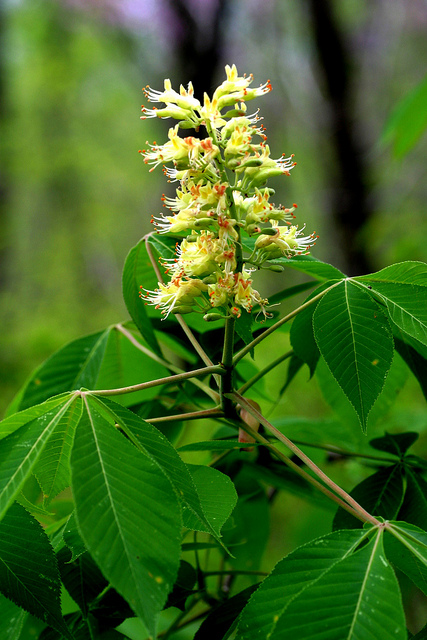The perceived healing power of the buckeye nut explains the scientific name for this genus, Aesculus, named after Aesculapius, the mythological Greek god of medicine. The species name for the Ohio buckeye, glabra, was later added to distinguish it from the closely related yellow buckeye (as both were commonly found throughout the valleys and ravines along the Ohio River).
It is the state tree of Ohio, but in Toronto and York Region, we are at the northern range for this species - our climate is just mild enough to plant it. But you wouldn’t be the first! According to John Laird Farrar in Trees in Canada, a large population of Ohio buckeyes was found in a natural forest in southwestern Ontario on Walpole Island (at the north end of Lake St.Clair). It may have its roots in Ohio, but the buckeye sure seems to like it up here.

Unlike most other deciduous trees, the Ohio buckeye is easy to spot in winter because of its unusual form: broad with a rounded crown and low, drooping branches that curve up at the tips. Its uniquely soft, close-grained wood is easily carved and whittled, which makes it quite popular for crafting utensils, platters, woven baskets, and even artificial limbs.

In early spring, showy, fragrant clusters of upright, yellow-green flowers develop, attracting a variety of hummingbirds and butterflies. Bright green, palmate compound leaves then emerge, each with five oblong leaflets that poet Albrecht Dürer described as “praying hands”. Autumn foliage is commonly yellow but can develop attractive shades of red and brown, or even pumpkin orange.

The familiar buckeye fruit - one or two seeds enclosed in a slightly spiny, golden brown husk - turns a smooth and shiny, dark mahogany brown with a light tan eye when ripe. Because of its colouring, the buckeye nut was often called “hetuck,” meaning eye of a buck, which is where the common name originates. I’ve read that when roasted, peeled and mashed, the buckeye nut makes for a nutritional meal; though it’s not something I can say I’ve tried myself!

An attractive tree with lots of personality, the Ohio buckeye is a perfect addition to the Backyard Tree Planting Program’s list of native species for 2014! So, if this cold weather has you feeling unlucky book a consultation and ask about this tree. As we all know, the only sure thing about luck is that it will change.
Brenna Anstett is the Field Operations Coordinator with LEAF. The Backyard Tree Planting Program is supported by Ontario Power Generation, York Region, Ontario Trillium Foundation, The City of Markham and Toronto Hydro.
